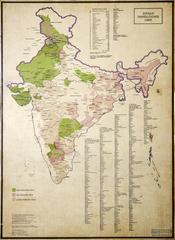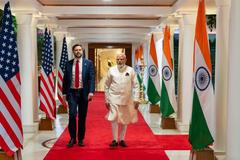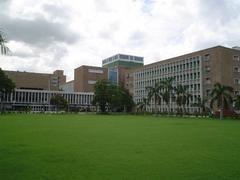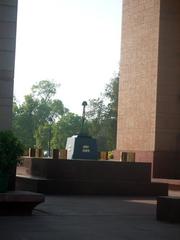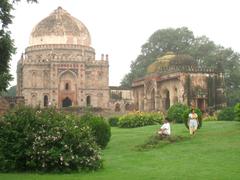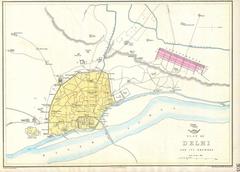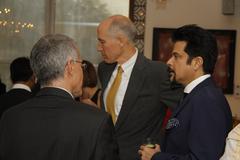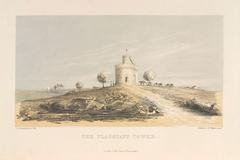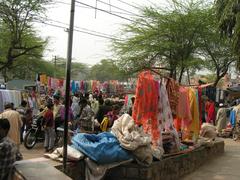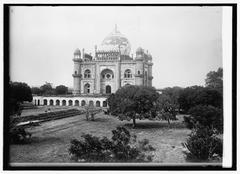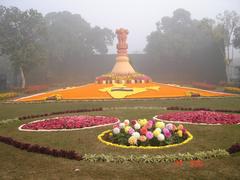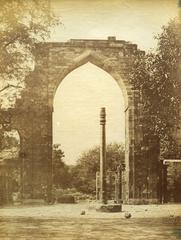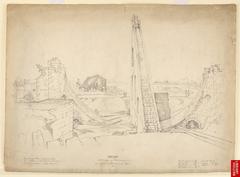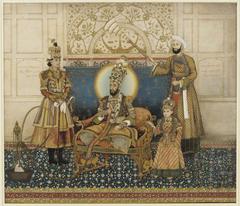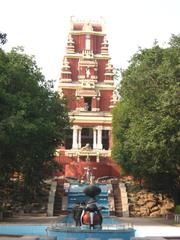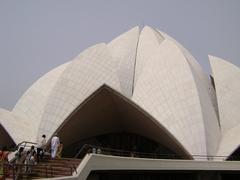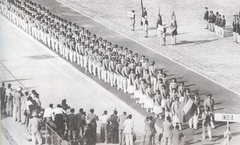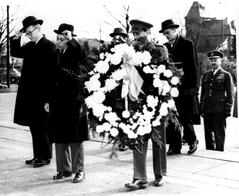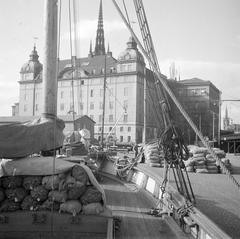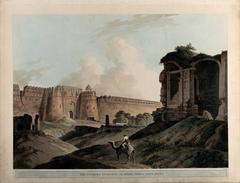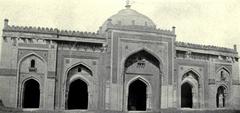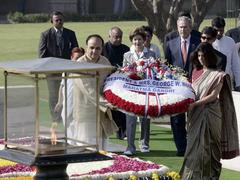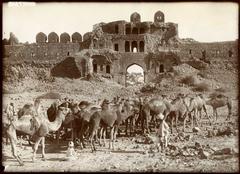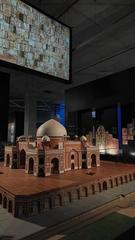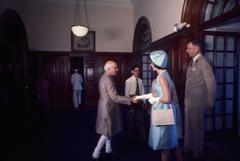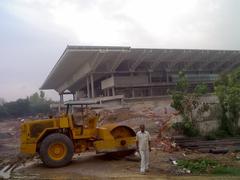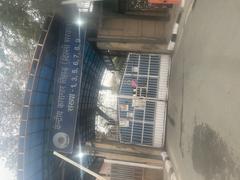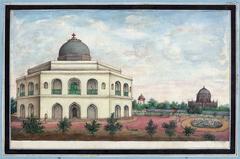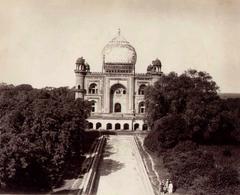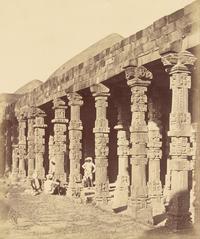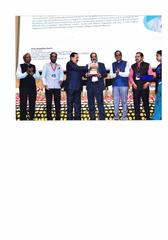
Visiting National Handicrafts and Handlooms Museum, New Delhi - Hours, Tickets, and Tips
Date: 16/08/2024
Introduction
Nestled in the vibrant city of New Delhi, the National Handicrafts and Handlooms Museum, commonly known as the Crafts Museum, is a cultural treasure trove that offers a profound insight into India’s rich heritage of traditional arts and crafts. Established in 1956 by the All India Handicrafts Board, the museum was the vision of Kamaladevi Chattopadhyay, a renowned social reformer and freedom fighter. She envisioned the museum as a dynamic space where artisans from across India could come together to preserve and showcase their crafts (Wikipedia). The museum’s architecture, designed by the acclaimed architect Charles Correa, seamlessly blends traditional and modern elements, creating an ambiance reminiscent of a traditional Indian village (Culture and Heritage). With over 35,000 artifacts, the museum provides a comprehensive journey through India’s diverse cultural heritage, featuring everything from textiles and embroidery to stone and wood carvings. Beyond its exhibits, the museum is a vibrant center for cultural and educational activities, hosting workshops, seminars, and live demonstrations that offer visitors a unique opportunity to engage with India’s craft traditions (Travel Setu). Whether you’re a history enthusiast, a craft lover, or simply a curious traveler, the National Handicrafts and Handlooms Museum promises an enriching experience that celebrates the artistry and ingenuity of Indian artisans.
Table of Contents
- Introduction
- History and Significance
- Architectural Significance
- Collection and Exhibits
- Educational and Cultural Programs
- Renovations and Controversies
- Research and Documentation
- Visitor Experience
- Accessibility and Amenities
- Travel Tips and Nearby Attractions
- Special Events and Guided Tours
- Photographic Spots
- FAQ
- Conclusion
History and Significance
Establishment and Evolution
The National Handicrafts and Handlooms Museum was established in 1956 by the now-defunct All India Handicrafts Board. The museum was the brainchild of Kamaladevi Chattopadhyay, a prominent social reformer and freedom fighter, who envisioned it as an ethnographic space where craftsmen from various parts of India could come together to preserve traditional arts and crafts (Wikipedia).
The museum’s development spanned over three decades, starting in the 1950s and 1960s. By the 1980s, it had amassed a substantial collection of artifacts, and the museum space gradually evolved into its present form. The building, designed by renowned architect Charles Correa between 1975 and 1990, incorporates traditional architectural elements into a modern design (Culture and Heritage).
Architectural Significance
The museum’s architecture is a blend of traditional and modern styles, reflecting India’s rich cultural heritage. Charles Correa’s design includes elements such as sloping tiled roofs, small windows, and punctured iron screens, creating a rural ambiance that mimics a traditional Indian village. The entrance passage, fringed with pigeon huts and decorated with arches and filigree panels, sets the tone for the visitor’s journey through India’s craft traditions (Delhi Information).
Collection and Exhibits
The museum houses over 35,000 rare and distinctive pieces that reflect the continuing tradition of Indian craftsmanship. These include paintings, embroidery, textiles, and various crafts made from clay, stone, and wood. The collection is displayed in five galleries, three courtyards, and walk-through passages, showcasing the diverse cultural heritage of India (Culture and Heritage).
Textiles
The museum is renowned for its extensive textile collection, featuring Kalamkaris, Jamawars, Pashmina and Shahtosh shawls, Kanthas, Chikankari works, and Bandhani fabrics. Rare brocade and Baluchari saris, Kutch embroidery, and precious metal jewelry are also on display (Culture and Heritage).
Sculptures and Carvings
The museum boasts a collection of stone and wood carvings, including a 300-year-old Bhuta sculpture from Karnataka and bronze figures from the tribes of Chhattisgarh (Delhi Information).
Village Complex
Spanning over 5 acres, the Village Complex features 15 structures representing village dwellings, courtyards, and shrines from different states of India. This complex was initially part of a temporary exhibition on rural India held in 1972 and was later incorporated into the museum (Culture and Heritage).
Educational and Cultural Programs
The museum is not just a repository of artifacts but also a vibrant center for cultural and educational activities. It hosts workshops, seminars, and collaborative initiatives to nurture and sustain India’s textile traditions. These programs empower artisans and craftsmen to adapt their skills to contemporary tastes while staying true to their cultural roots (Culture and Heritage).
Renovations and Controversies
In 2015, the Government of India announced the establishment of a Hastkala (handicrafts) Academy within the museum premises. This initiative aimed to convert some galleries into classrooms to train artisans. However, the renovations led to the destruction of one of the museum’s most well-known artifacts, a room of murals painted by Madhubani artist Ganga Devi, resulting in widespread criticism (Wikipedia).
Research and Documentation
The museum houses extensive research and documentation facilities, including a reference library with around 10,000 books on textiles, arts, crafts, and Indian culture. It also features a conservation laboratory, a photo laboratory, and an auditorium, making it a hub for scholarly research and preservation of India’s craft heritage (Culture and Heritage).
Visitor Experience
Visitors to the museum can explore a wide range of traditional crafts, including textiles, woodwork, terracotta, and metalwork. Live demonstrations by skilled artisans provide a unique opportunity to witness the intricacies of craft-making, from spinning and weaving to block printing and embroidery. The museum also organizes special craft demonstration events throughout the year, where artisans from different parts of India display their skills (Travel Setu).
Accessibility and Amenities
The museum is located on Bhairon Marg in Pragati Maidan, facing the Purana Qila complex. It is easily accessible by local transport and the Delhi Metro, with Pragati Maidan Metro Station being the nearest point. The museum is open from 9:30 AM to 5:00 PM, except on Mondays and national holidays. The entrance fee is nominal, with special rates for students and foreign nationals (Delhi Information).
Travel Tips and Nearby Attractions
When planning your visit, consider the following travel tips:
- Wear comfortable shoes as the museum grounds are extensive.
- Plan your visit early in the day to avoid crowds.
- Nearby attractions include the Purana Qila (Old Fort), National Science Centre, and India Gate, making it easy to explore multiple sites in one day.
Special Events and Guided Tours
The museum hosts various special events and guided tours throughout the year. These include craft demonstrations, cultural performances, and thematic exhibitions. It’s advisable to check the museum’s official website or contact them directly for information on upcoming events and guided tour schedules.
Photographic Spots
The museum offers numerous picturesque spots perfect for photography enthusiasts. The Village Complex, with its traditional structures and vibrant murals, provides a stunning backdrop for photos. Don’t miss the intricately designed entrance passage and the beautifully displayed textiles in the galleries.
FAQ
What are the visiting hours of the National Handicrafts and Handlooms Museum?
- The museum is open from 9:30 AM to 5:00 PM, except on Mondays and national holidays.
How much are the tickets for the National Handicrafts and Handlooms Museum?
- The entrance fee is nominal, with special rates for students and foreign nationals.
Are guided tours available?
- Yes, guided tours are available and highly recommended.
Can I take photographs inside the museum?
- Photography is allowed in most parts of the museum, but the use of flash and tripods is generally prohibited.
Conclusion
The National Handicrafts and Handlooms Museum serves as a beacon of India’s rich cultural heritage, celebrating the artistry, ingenuity, and resilience of its artisans. It stands as a testament to the country’s commitment to preserving and promoting traditional crafts, ensuring that these age-old techniques continue to inspire and thrive in the modern world. By providing a platform for artisans to showcase their skills and interact with visitors, the museum fosters a deeper appreciation for India’s diverse craft traditions. It also plays a crucial role in educating the younger generation about the cultural significance of these crafts, ensuring that they remain an integral part of India’s cultural identity.
In conclusion, the National Handicrafts and Handlooms Museum is more than just a repository of artifacts; it is a celebration of India’s cultural heritage and a hub for preserving and promoting traditional crafts. Its extensive exhibits, live demonstrations, and engaging workshops offer a rich and multifaceted experience, making it a must-visit destination for anyone interested in India’s craft traditions. Don’t forget to check out other related posts, follow on social media for updates, and download the mobile app Audiala for a more enriched experience.
References
- Wikipedia, 2024, National Handicrafts and Handlooms Museum source url
- Culture and Heritage, 2024, Crafts Museum, New Delhi: A Journey into India’s Rich Craft Heritage source url
- Culture and Heritage, 2024, The National Handicrafts and Handlooms Museum, Delhi source url
- Travel Setu, 2024, Things to do in National Handicrafts and Handlooms Museum source url
- Delhi Information, 2024, Crafts Museum source url
